Overcoming Repeated Obstacles, Kilung Foundation
Rebuilding Shedra Monastic College in Tibet
Written by: Cary Peterson
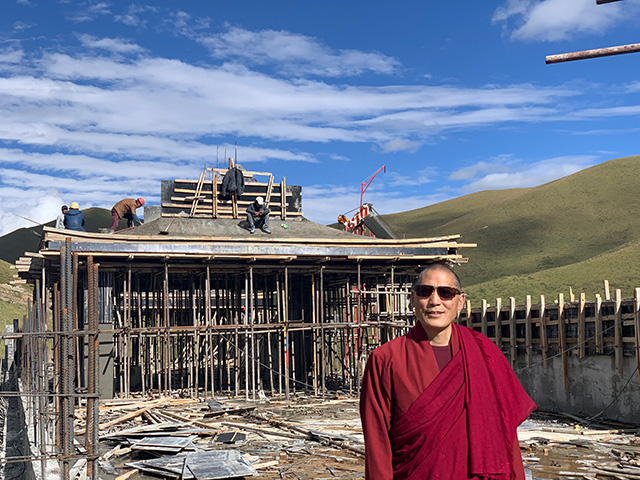
Dza Kilung Rinpoche on the roof of the new shedra, replacing the structure destroyed during the 2016 fire.
Photos by: Photos courtesy of Kilung Foundation
With support from Kilung Foundation near Seattle, a new Kilung monastic college is rising in Tibet, from the ashes of a devastating 2016 fire that destroyed the prior structure.
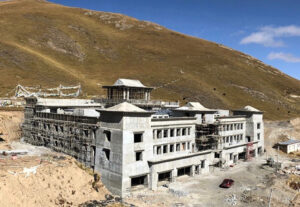
The shedra structure nearly complete, at the end of fall 2020 building season.
Banging, grinding and humming noises of construction ring through the thin air at 14,000 feet. With the pouring of concrete, welding of a solar cap, and creating forms for the fine detail of traditional Tibetan design, the Kilung Shedra (monastic college) will be an extraordinary structure, built to withstand earthquakes, fire and the rigors of high-altitude winters.
While contractors started the 2021 building season expecting shedra completion in the fall, the skyrocketing cost of building materials due to the pandemic has pushed up costs. Now Kilung Foundation urgently needs to raise an additional $130,000 to finish the structure this summer. Another challenge to overcome, and donations are warmly accepted!
The new Kilung Shedra, Children’s School, and Community Center will restore a Tibetan center of learning and higher education to monks whose monastic education was interrupted by the fire, and to children whose Tibetan education was stopped. It will also provide facilities for primary and preventative health care, and community development activities.

The architect’s rendition of the completed shedra.
Dating from 1770, Kilung Monastery has been a great center of learning and practice in the Nyingma Longchen Nyingtik lineage. His Eminence Dza Kilung Rinpoche, the current head of the Kilung Monastery, is the fifth incarnation of Jigme Ngotsar Gyatso, one of the four heart-sons of Jigme Lingpa. Kilung Rinpoche has been working since he was a teenager, to reestablish Kilung Monastery as a center of learning and practice.
Since 1998 this work has been supported by Kilung Foundation, a non-profit organization based on Whidbey Island, Washington. Also on the Whidbey Island site is Phagtsok Gedun Choling Temple, a traditional Tibetan structure that is Rinpoche’s dharma seat in the West.
Kilung Foundation has for five years been raising the $1.7 million needed to build the 63,500-square-foot shedra. Before work started the burned structure had to be demolished, the site cleared, geological surveys completed, and the architectural plans developed for the three-story environmentally sensitive building.

An unusual retreat structure, built on the on Kilung Shedra roof.
Construction began the in summer of 2018. Despite the short building seasons, it’s been amazing to see the enormous progress that can be made by a huge construction crew working day and night.
The original Kilung Shedra building was destroyed during the Cultural Revolution. In 2005 Dza Kilung Rinpoche and the Kilung Foundation raised the funds to rebuild the structure, and to restart intensive study of Tibetan Buddhist dialectics and spiritual philosophy that is essential for developing skilled and educated monastic teachers and practitioners.
The first nine-year program of the revitalized shedra was very successful, and a second nine-year program began in 2014. The Shedra also became the home to the Kilung Children’s School in 2014, providing Tibetan education to boys aged 8 – 12.
But then in 2016 an accidental fire destroyed the entire structure, and all these essential education opportunities.
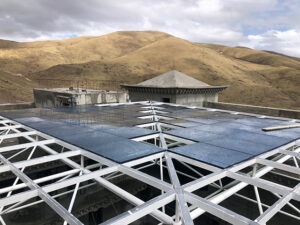
The solar panels, when complete, will protect the courtyard from the elements and warm it.
“The community is heartbroken with the loss of the source of Tibetan culture and Buddhist legacy and study,” Dza Kilung Rinpoche said at the time. “We cannot let this devastating fire take away our younger generation’s learning opportunities. We will rebuild this important center again, no matter what hardships we may have to go through.”
Rinpoche also took the catastrophic event as an opportunity to rebuild the shedra with modern materials and innovative building techniques, to provide digital access and expanded facilities for the greater community. Classrooms for girl’s education, a health clinic, and community rooms will extend the educational and humanitarian benefit of the shedra.
One of the most special features of the new Kilung Shedra is the solar cap. This large expanse of special glass will cover most of the inner courtyard, providing passive solar heat for the building. It will create sun-warmed sheltered spaces where students and monks can study during the day, and will produce passive solar heat for adjacent areas.
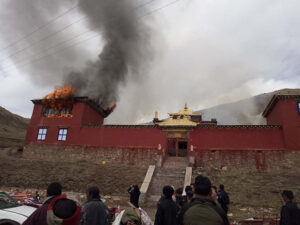
The prior shedra burning during the 2016 fire.
Kilung Rinpoche, with the advice of specialized engineers, chose this design to avoid the environmental impact of heating with coal, and to minimize costly electric heating bills.
Also innovative in the shedra design is the addition of retreat facilities on the top floor of the structure. While monks often must choose between meditation retreat or academics, the new shedra will help integrate practice with studies.
In addition to raising additional funds for pandemic-related materials costs, Kilung Foundation is also raising funds for equipment and supplies. All was lost in the fire and everything needs to be replaced – statues and sacred paintings called thangkas, sacred texts and school books, kitchen supplies, desks, and beds…the list is long!
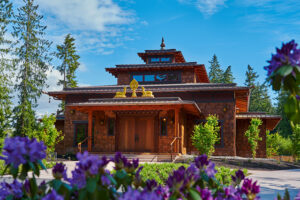
Phagtsok Gedun Chöling Temple at the Yeshe Long Buddhist Center on Whidbey Island.
Particularly important is the new health clinic. Many Tibetan nomad families suffer from tuberculosis, hepatitis B, and hydatid disease, all preventable but very prevalent in the Dzachuka region near the shedra.
Currently Tibetans have very little access to medical care and prevention. The clinic will provide essential vaccinations and health checks, and education for family planning and child nutrition.
The community center will be a gathering place for the nomad community, and also a training center for uniquely Tibetan traditional skills in thangka painting, making clothes, tents, handicrafts, and foods. The community center will also have facilities for technical education, to support sustainable economic development.
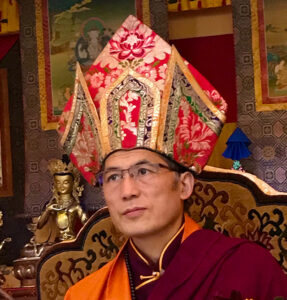
Dza Kilung Rinpoche leading a Whidbey Island retreat.
Local people and monks are anticipating the reopening of the shedra, and restarting of the Nine-Year Program. The shedra will support monastic students, who have faced difficulties keeping their studies going in the five years since the shedra burned down.
Dza Kilung Rinpoche hopes the shedra can reopen in the fall, and is asking for help to raise the $130,000 needed to make this aspiration come true. To donate, please use https://www.kilung.org/donate/.
With every weld and every concrete pour, each book in the library, each sacred object in the temple and vaccine in the clinic, the goal of once again providing a center where Tibetan Buddhist education, culture, and community will thrive, comes closer to fruition.
Cary Peterson is a long-time student of Dza Kilung Rinpoche, and also serves on the board of the Kilung Foundation. She has traveled on pilgrimage to Dzachuka, central and western Tibet, India and Nepal.
